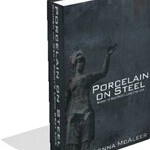
Kathryn Atwood
“A Very Dangerous Woman: Martha Wright and Women’s Rights”
By Sherry H. Penney and James D. Livingston
ISBN 1-55849-446-4
University of Massachusetts Press
“No matter what a wife’s annoyances may have been during the day, her countenance must always be wreathed in smiles on the approach of her husband.”
– Martha Wright, excerpt from a satirical newspaper piece.
“Just get hold of life’s reverses & disappointments in a ridiculous point of view, & it helps along wonderfully – there is a great deal of fun, among all the annoyances, if one can only find it.”
– Martha Wright, excerpt from a letter to a relative.
The first women’s rights convention, held in July, 1848, in Seneca Falls, New York, was organized by five women, two of which have achieved nigh-sainthood in women’s rights history: Lucretia Mott and Elizabeth Cady Stanton. Lesser known is Martha Wright, Lucretia Mott’s younger sister, also one of the Seneca Falls organizers, and the great-great-grandmother of author James D. Livingston. Livingston and his wife Sherry H. Penney have sought to shed light on Wright’s life and work with the publication of their book, “A Very Dangerous Woman.”
Twenty-first century readers might find the book’s title highly ironic when encountering the self-effacing, thoroughly domestic, and humorous Martha Wright within the pages of “Dangerous Woman.” But set within the framework of 19th century America, Martha Wright — who not only promoted abolition and repeatedly provided hospitality to Frederick Douglass, but whose home was also part of the underground railroad; who not only promoted the idea of female suffrage but also the concept of fair divorce and wage laws — was indeed deemed quite dangerous.
During the numerous women’s conventions that followed Seneca Falls, Wright served in various capacities but her main contribution was that of writer and the copious inclusion of her lively personal letters in “Dangerous Woman” sheds light not only on her variegated personality, the numerous women’s rights and abolitionist conventions she took part in, but also on the characters of 19th century luminaries who she encountered. For instance, after a visit from Elizabeth Cady Stanton, Wright was charmed: “We all fell in love with Mrs. Stanton, the merry twinkle of her eye and her genuine hearty laugh.”
After the war, when Harriet Tubman was settled in Auburn, she and Wright became quite close and when Tubman missed a chance to see Wright’s visiting daughter Ellen (married to the son of William Lloyd Garrison, one of Tubman’s heroes) and her new baby, Wright notes that Tubman was “so disappointed that her eyes filled with tears. She [had] never shed a tear in telling me of all her troubles.”
When she visited the Boston transcendentalists after the war (Bronson Alcott, father of the famed author, among them), she was unimpressed and wrote “Just between ourselves I think those radical meetings a great humbug. Each essayist, in turn, trying to see how obscure he can make his meaning, by wrapping it, like a mummy, in spiced cloths, and then aping Emerson in the reading.”
Penney and Livingston spend a good deal of time on the civil war and its affect both on the women’s movement in general (the push to grant suffrage to freed male slaves basically shelved the women’s suffrage movement) and on Martha specifically. Her tolerance of those with differing opinions and her peaceable nature is evident in her continued correspondence with her confederate relations from her first marriage, even when war was looming. When one of these young relatives expressed his approval of the vicious attack on Senator Charles Sumner in retaliation for Sumner’s critical speech of a South Carolina senator, Martha reproved the young man thus: “I felt very sorry that you should justify the murderous attack on Sumner, & that you should be willing to endorse the sentiment, so unworthy an American citizen, that personal violence, under any circumstances, was allowable, for words uttered in debate . . . “
Yet, she signed off the correspondence thus: “I shall always be happy to hear from you & I trust that more mature reflection, & the generous impulses of youth, will lead you to judge wisely on this momentous question wh. is destined to shake the Union from centre to circumference.”
However, the war became close and personal when her own son joined the Union forces and it affected the generous nature of Quaker-born Wright: “I dread any misplaced ‘magnanimity’ towards the leaders of the Rebellion, & the murderers of our prisoners. I would not have one hanged, but disfranchised & their land confiscated.” Later she wrote even more pointedly, “I for one wd. rather the war wd. last till the South is depopulated.”
Her attitude says more about the war’s powerful influences than it does about Martha’s character because for the most part, Wright was a renowned peacemaker especially within the ranks of the sometimes divided woman’s movement. Attempting to make peace between these warring factions she once quipped: “What’s the difference between a bird with one wing & a bird with two? A mere difference of a pinion.” Indeed, her humor was such an intrinsic part of her nature that William Lloyd Garrison, writing an obituary after Wright’s death in 1875, said that “Beneath [Wright’s] habitual gravity there lurked a keen sense of the ludicrous, her wit and humor being always at command.”
“A Very Dangerous Woman,” like its subject, is intelligent but accessible, a long overdue biography on a very interesting – if occasionally, dangerous — woman.
“Kathryn Atwood’s book reviews have appeared in numerous print and online journals and she is the author of the new young adult title, “Women Heroes of World War II: 26 Stories of Espionage, Sabotage, Resistance, and Rescue.”



